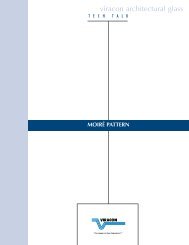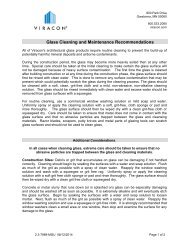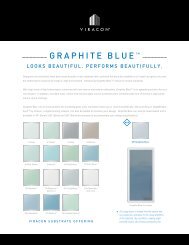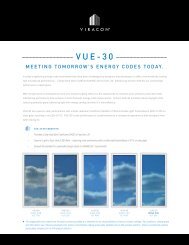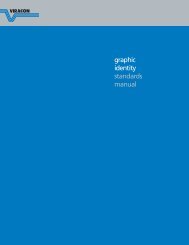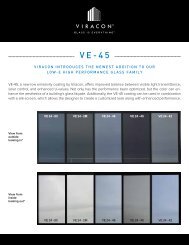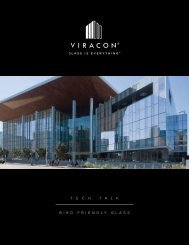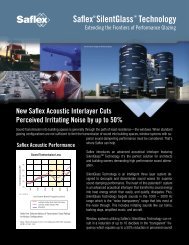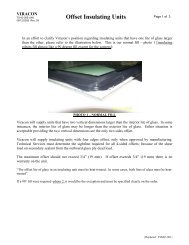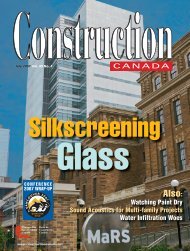2 0 1 3 P R O D U C T G U I D E VIRACON PRODUCT GUIDE 2013 ...
2 0 1 3 P R O D U C T G U I D E VIRACON PRODUCT GUIDE 2013 ...
2 0 1 3 P R O D U C T G U I D E VIRACON PRODUCT GUIDE 2013 ...
You also want an ePaper? Increase the reach of your titles
YUMPU automatically turns print PDFs into web optimized ePapers that Google loves.
SPANDREL GLASS<br />
matching spandrel and vision areas<br />
Often a project may require spandrel glass to harmonize with the vision areas of your building. However, this is sometimes difficult<br />
to achieve when high-light transmitting or low-reflective glass types are used. Low-light transmitting and high-reflective glass types<br />
provide the least contrast between vision and spandrel areas. Variable sky conditions can also influence our perception. On a bright,<br />
sunny day, the exterior light intensity is approximately 50 to 100 times greater than the interior lighting level.<br />
When viewing the glass from the outside, the dominant visual characteristic is the exterior reflection. On gray, overcast days, a<br />
greater visual disparity is created between vision and spandrel areas due to the transparency of the vision glass and the perception of<br />
depth created by interior lighting. The non-vision areas tend to look flat and two-dimensional by contrast. By keeping the vision and<br />
spandrel glass construction similar (the same exterior glass color, coating, etc.) the contrast can be minimized under various lighting<br />
conditions. Viracon recommends using a neutral colored ceramic frit on the fourth (#4) surface.<br />
Viracon recommends viewing glass samples or full-size mockups to match vision and spandrel glass areas when the visible<br />
light transmission of the vision glass exceeds 14 percent.<br />
Rice University,<br />
Brockman Hall for Physics<br />
LOCATION: Houston, Texas<br />
GLASS TYPE: VE1-2M<br />
ARCHITECT: KieranTimberlake<br />
GLAZING CONTRACTOR: Admiral Glass Co.<br />
PHOTOGRAPHER: Alissa Schmidt<br />
MOIRé PATTERN<br />
Moiré is an optical phenomenon that may present itself as a “wavy, rippled or circular” pattern under certain conditions. Moiré<br />
patterns can be created whenever one semi-transparent object with a repetitive pattern is placed over another. The moiré<br />
pattern is not a glass defect, but rather a pattern in the image formed by the eye. For additional information, please review<br />
Viracon’s Moiré Pattern Tech Talk on our website at viracon.com.<br />
<strong>VIRACON</strong> // COMPONENTS & ENHANCEMENTS<br />
017



